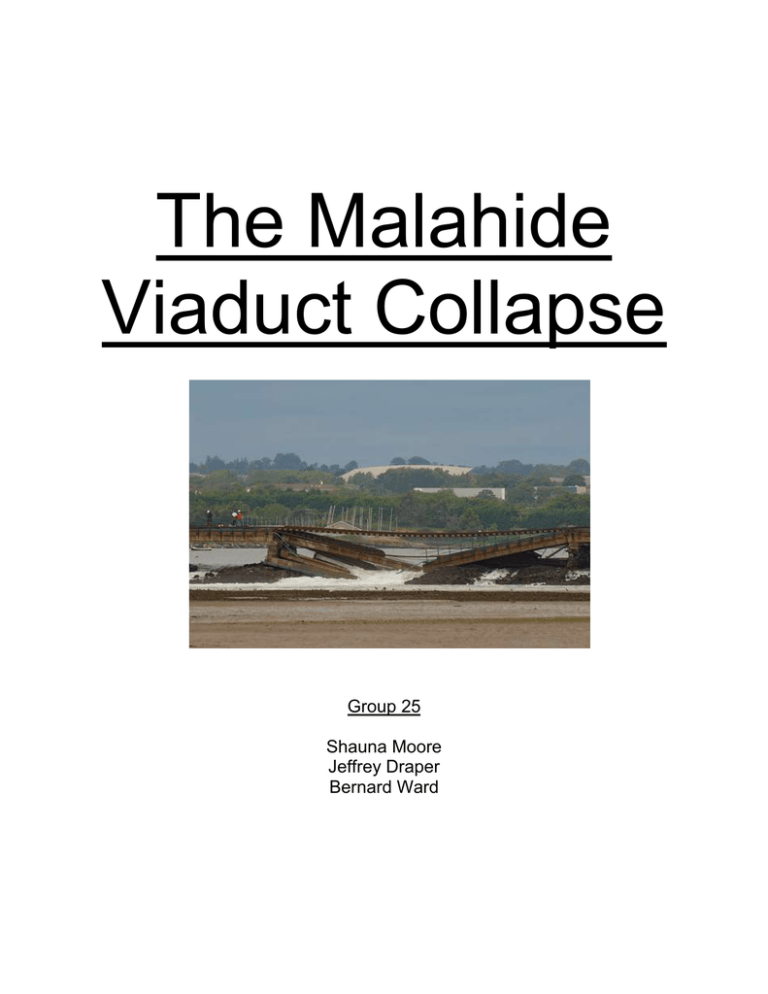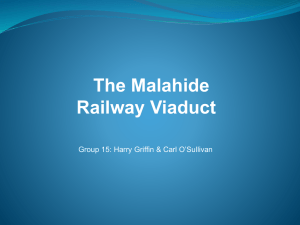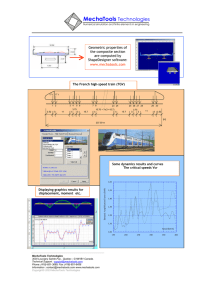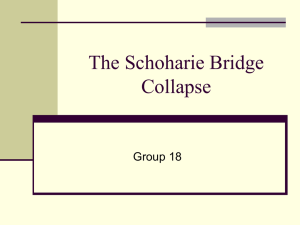disaster report_25.doc
advertisement

The Malahide Viaduct Collapse Group 25 Shauna Moore Jeffrey Draper Bernard Ward Introduction The viaduct is a long-standing structure dating back to 1844 and has since been rebuilt twice since the original structure. The 176 metre long twin-track viaduct, situated north of Malahide station, about 9.5 miles from Connolly station is one of the largest precast superstructures in Ireland today. It is of up most importance as it connects Ireland’s two largest cities, Dublin and Belfast, with the ‘enterprise’ service, provides commuter services for towns north of Dublin city and it used by freight trains servicing Tara Mines in Co. Meath. History of the structure The original structure, which dates back to 1844, was constructed for the Dublin Drogheda railway and so was built over the Broadmeadow Estuary between Malahide and Donabate in north Dublin. Originally the frame was built on timber trestles forming 11 spans. Scouring occurred from the huge tidal currents and the foundations of the frame began to sink. In order to overcome this and secure stability 90,000 tonnes of stone were discharged along the line of the bridge until a virtual stone ‘weir’ was formed across the tideway creating a retaining effect on the water. In 1860 the timber viaduct was replaced and new masonry piers were constructed on the stone weir. The 11 piers are gravity structures without piled foundations, with a rock weir in between the piers to reduce tidal flows between the piers. Nine piers are centred at 15.85m, with the abutment and first and last piers at each end centred at 12.25m. This new structure was composed of wrought iron lattice girders, 6 per span4 under the rails of the track and 2 on the outside parapet girders. This structure continued in service until 1932 when it was strengthened again by adding a plate girder in the centre of each track supporting the two rail girders on either side. This bridge worked well and ensured the safety of the users however the iron work deteriorated quickly due to the high exposure to a marine environment. The bracing members also deteriorated and became fractured due to the sway and vibrations of the rail traffic and scour was an issue with more than 8,000 tonne of rock being added to the weir between 1915 and 1924 and so the decision was made to renew Malahide viaduct. A new viaduct was completed between 1966 and 1967 where the iron structure was replaced with a prestressed precast concrete deck simply supported over masonry piers which had a new layer of bedding stones added at the top of the original masonry pier to support the new and heavier concrete structure. The bedding stone was coated with a special grout, which is immiscible with water so it is not affected by the wave action, to stabilise the weir. In the precast concrete deck they used cables of 7 wire strand rather than usual pre-stressing wire as it gave a better anchorage. A total of 2040 tonnes of precast prestressed concrete was used and was designed to withstand the maximum 20 tonne load applied from the enterprise service. The Collapse On Friday 21st August, a few moments after a commuter train passed along the twin line track, a 20 metre section of the viaduct pier collapsed. It collapsed after one of the supporting masonry piers crumbled after scouring. Bridge scour is an engineering term for water-induced erosion of the soil surrounding bridge foundations including piers and abutments. The collapse unfolded because: 1. There was a creation of a breach in the rock weir, (which was constructed to reduce tidal flow between the piers and runs the length of the bridge.) This breach was noticed by canoeists in July and reported. 2. This breach in the weir created a v-notch effect which led to increase water flow and pressure. 3. This led to an increased flow around the bridge piers. 4. The increase in water pressure caused erosion to the riverbed around the bridge pier and as it was a Victorian masonry pier it had no supporting piles and so the pier crumbled – scouring had occurred. The collapsed span of the viaduct The scoured pier Thankfully no-one was injured when the pier collapsed and the alarm had been raised by a driver who noticed a huge subsidence in the track as the train passed over it and so all trains had been halted. However many feel trains should have been halted before this. A 1998 safety examination report covering the entire network in the Republic of Ireland by International Risk Management Services for the Irish government gave the viaduct a 40% “safety inadequacy” rating and the embankment a 60% rating, making it one of the least safe stretches of infrastructure in the country., In July 2009, after canoeists had altered authorities to a channel developing in the weir ‘like it had been gouged out by a JCB’, engineers had inspected the viaduct and the piers 3 days before the collapse and identified no visible structural issues and although some cracks were noticed, they were only cosmetic and had no relation to the collapse. A track monitoring vehicle had checked the track the day before the collapse and no movement in the track was apparent so it is believed that in a very small timescale increased water pressures had a huge effect on the seabed. It was also noted that there were very low tides and very heavy rainfall on 19th August, 2 days before the collapse. These two factors coupled together meant the volume and speed of the water flowing out of the estuary was hugely increased, causing a huge increase in water pressures and therefore widening the breach at a very quick rate. This added to the already bad effect and led to a sudden and catastrophic collapse. Conclusions Although there was a lot of monitoring in place and regular checks being carried out it was not enough to prevent a collapse. Since the collapse, the entire 176 metre span of the viaduct is being carefully inspected and they have increased the frequency of checks. Since the collapse they have realised that the track inspection vehicle gave inaccurate readings by up to 50% and this has now been rectified. Work has already begun on repairing the breached weir in order to normalise water flows to protect adjacent piers. Irish Rail is hoping to rebuild the collapsed pier and strengthen those on either side of the collapsed pier and continue regular checks to ensure another failure of this type along the viaduct will not happen again however in the long term a new longer span bridge, will be needed. References: New Civil Engineer, September 2009 issue, “Scour revealed as cause of Irish bridge collapse” http://www.railusers.ie/ http://en.wikipedia.org/wiki/Broadmeadow_viaduct The Institute of Engineers Ireland, Transaction, Vol. 95, Session 68-69



